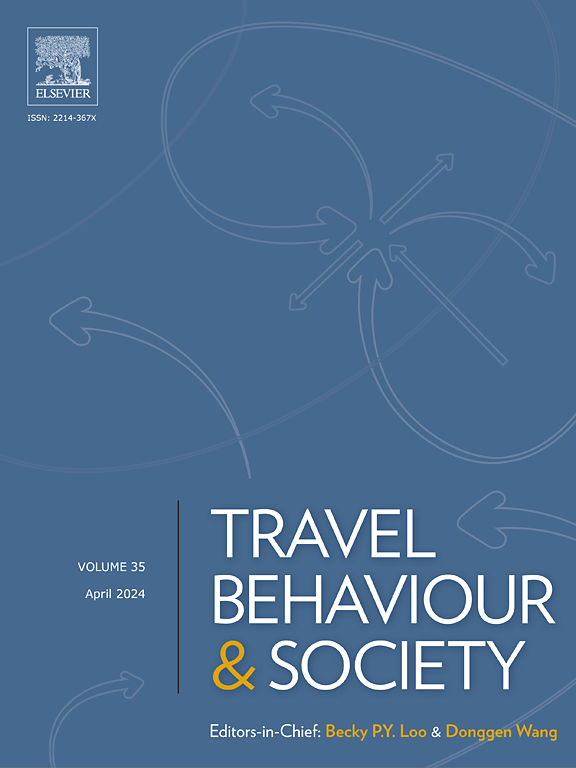A novel integrated machine learning and inferential modeling approach to explore non-linear effects of built environment on travel: a three-wave repeated cross-sectional study
IF 5.7
2区 工程技术
Q1 TRANSPORTATION
引用次数: 0
Abstract
This study investigates the dynamic effects of the built environment on travel in Austin, Texas, over a 20-year period. Using three waves of household travel surveys from 1997, 2006, and 2017, the research employs a repeated cross-sectional approach to address the limitations of traditional longitudinal and cross-sectional studies, and to more accurately estimate effect sizes. Methodologically, we introduce a novel integration of machine learning and inferential modeling to uncover non-linear relationships and threshold effects of the built environment characteristics on travel. Using Gradient Boosted Decision Trees (GBDT) and Partial Dependence Plots (PDPs), we first identify optimal threshold points in the relationships, which are then incorporated into piecewise multilevel models.
Findings from the study reveal that the built environment serves as a sustainable tool for managing travel in the long term, contributing 50 % or more to the total feature importance in predicting individual travel—surpassing the combined effects of personal and household characteristics. Improved transit accessibility, enhanced local and regional accessibility, higher population and employment densities, and greater diversity are all associated with significant reductions in travel—particularly within their identified thresholds—though the magnitude of their influence varies across time periods and shows diminishing marginal returns.
These findings highlight the potential of smart growth policies—such as expanding transit accessibility, promoting high-density and mixed-use development, and discouraging single-use development and peripheral sprawl—as effective strategies to reduce car dependency and manage travel demand. Moreover, the study demonstrates that the proposed integrated approach can effectively capture complex non-linear effects while enhancing flexibility and interpretability, reducing researcher bias, and enabling statistical inference—ultimately providing more robust and policy-relevant insights.
一种新的集成机器学习和推理建模方法来探索建筑环境对旅行的非线性影响:三波重复横断面研究
本研究调查了20多年来德克萨斯州奥斯汀市建筑环境对旅行的动态影响。利用1997年、2006年和2017年的三波家庭旅行调查,该研究采用了重复的横断面方法来解决传统纵向和横断面研究的局限性,并更准确地估计效应量。在方法上,我们引入了机器学习和推理建模的新集成,以揭示建筑环境特征对旅行的非线性关系和阈值效应。利用梯度提升决策树(GBDT)和部分依赖图(pdp),我们首先确定了关系中的最佳阈值点,然后将其纳入分段多级模型。研究结果表明,从长远来看,建筑环境是管理旅行的可持续工具,在预测个人旅行的总特征重要性中贡献了50%或更多,超过了个人和家庭特征的综合影响。交通可达性的改善、当地和区域可达性的提高、人口和就业密度的提高以及多样性的增加都与旅行的显著减少有关,特别是在其确定的阈值范围内,尽管其影响的程度因时期而异,并且边际收益递减。这些发现强调了智能增长政策的潜力,例如扩大交通可达性,促进高密度和混合用途开发,阻止单一用途开发和周边扩张,作为减少汽车依赖和管理出行需求的有效策略。此外,该研究表明,所提出的综合方法可以有效地捕捉复杂的非线性效应,同时增强灵活性和可解释性,减少研究者偏见,并实现统计推断,最终提供更稳健和与政策相关的见解。
本文章由计算机程序翻译,如有差异,请以英文原文为准。
求助全文
约1分钟内获得全文
求助全文
来源期刊

Travel Behaviour and Society
TRANSPORTATION-
CiteScore
9.80
自引率
7.70%
发文量
109
期刊介绍:
Travel Behaviour and Society is an interdisciplinary journal publishing high-quality original papers which report leading edge research in theories, methodologies and applications concerning transportation issues and challenges which involve the social and spatial dimensions. In particular, it provides a discussion forum for major research in travel behaviour, transportation infrastructure, transportation and environmental issues, mobility and social sustainability, transportation geographic information systems (TGIS), transportation and quality of life, transportation data collection and analysis, etc.
 求助内容:
求助内容: 应助结果提醒方式:
应助结果提醒方式:


